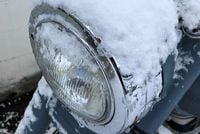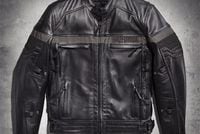Riding a Motorcycle in Cold Weather
Riding a motorcycle in the winter can be tough, but the right cold weather gear and some tips to help navigate cold and icy roads can go a long way.
Riding a motorcycle in the winter can be tough, but the right cold weather gear and some tips to help navigate cold and icy roads can go a long way. The first thing any rider should do is check the forecast. Checking the weather is standard procedure for any motorcyclist, but this is especially true during the winter months. Whether you’re planning for a long ride, or simply need to bike to work the next day, the temperature outside will determine more than you think, and staying tuned in to the forecast is essential.
Riding in the Snow and Ice
If you get caught in a snowstorm, rule number one is don’t panic. Riding a motorcycle in the snow simply requires you to slow down, be smooth, and allow plenty of distance for braking. It’s also important to ensure other vehicles aren’t following too closely. Falling down at such a low speed probably won’t cause a serious injury, but a car behind you that can’t stop in time certainly can. Snow will also undoubtedly make you harder to see. Other vehicles are more likely to cut you off or stop without warning, and it’s best to get off the road as soon as possible.
The other hazard of riding a motorcycle in cold weather is ice. Be extra cautious over bridges that might freeze and be alert for black ice in shady areas. If you must cross an icy patch, keep the bike slow, straight and steady. It’s common for tires to stiffen up in such conditions, and this will hurt your traction on the road even more. Snow tires for motorcycles are available, and if you live in an area where snow falls frequently, it may be worth the investment.
Managing Bike Fluids in Cold Weather
Maintaining fluid levels is critical to keeping your bike working during the winter. You should consistently check oil and antifreeze levels to prevent internal damage, and keep your gas tank half full to prevent the gas lines from freezing. Using thinner oil can help improve performance, but check your owner’s manual for recommendations because some manufacturers require specific oils regardless of temperature.
Don’t forget to keep your bike clean as well. Consistent cleaning during the winter is key to keeping corrosive elements at bay. You might consider a wax treatment before the cold arrives as a layer of protection from snow and road salt. For more helpful tips on riding a motorcycle in cold weather and ways you can stay safe through winter, check back with us for in-depth reviews on parts, products and gear.
Cold Weather Motorcycle Gear
You can ride in cold temperatures safely and comfortably as long as you dress properly, but an extended ride in freezing weather can get you into trouble if you don’t have the right gear. Cold weather motorcycle gear needs to be thick and insulated, but also have the same comfort and safety features as other motorcycle gear to keep you protected on the bike.
It’s important to bundle yourself up with thermal layers around your core, as well as a buff or balaclava to keep your face out of the wind and cold. Insulated gloves and boots, as well as thick socks and glove liners can be a necessity during the winter as well. We review the best cold weather motorcycle gear, and whether you’re searching for basic essentials like jackets, pants, helmets, or face masks, or more advanced equipment like electric gear with wired heaters, we’ve got you covered regardless of style or budget.
As long as you have the right gear and avoid the slick spots, riding a motorcycle in cold weather can be as comfortable and fun as riding on warm days. And the investment you make in cold weather gear will only enhance your investment in your bike. Check back regularly for updates on the newest motorcycle apparel and accessories for riding through winter.


/cloudfront-us-east-1.images.arcpublishing.com/octane/2Y25M76O4ARKMV4T7MVH2SHRWU.jpg)
